Subsea
Pre-takeoff checklist
- Joined
- Feb 27, 2015
- Messages
- 232
- Display Name
Display name:
Subsea
Plane is in annual They are "concerned about compression on 2 of the cylinders" He said they are in the 30s which I find puzzling as 3 weeks ago they said everything was in great shape.
We'll see... If there is an issue, I hope they can overhaul versus replace otherwise this is going to do bad things to my airplane fund.
airplanes are stupid.
The last time I had bad IO550N jugs, the price delta between rebuilding and replacing was only a couple hundred dollars each. In my opinion, if it is between a couple hundred dollars, it is worth just to buy new (labor is going to be the same). If anything, it is worth the time it takes to send them away and be rebuilt.
Do you know if the compression was escaping through the rings into the crankcase, or out of the exhaust valve?
What year engine? Mine was a 2006 and had one set under warranty and I paid for the second. There is a rumor that Continental had a dark period in the 2000s where longevity in big bore cylinder heads was **** poor. In my experience, I believe it.
From Continental SID 97-2b
1. DIFFERENTIAL COMPRESSION CHECK
a. Perform Differential Compression Check in accordance with the latest revision of TCM
Service Bulletin SB03-3 and record the master orifice tool reading.
1. For cylinders with differential pressures greater than the minimum allowable
calibrated compression reading, and borescope inspection reveals no abnormalities,
then continue in service.
2. For cylinders with differential pressures less than the minimum allowable calibrated
compression reading, a borescope examination must be performed and the aircraft
flown at power with a re-check of the suspect cylinder. If the cylinder leakage rate is
still below the minimum allowable calibrated reading, the leakage source must be
determined and corrected.
3. For cylinders where leakage by the valves is identified, perform a borescope
inspection of the affected cylinder(s). If the leakage rate is above the minimum
allowable calibrated compression reading, and borescope examinations reveal no
abnormalities, continue in service. If the leakage rate is below the minimum
allowable calibrated compression reading, and borescope examinations reveal no
abnormalities, operate the engine to normal temperatures and recheck cylinder
differential leakage.
4. For cylinders where leakage by the rings or valves is less than the minimum
allowable calibrated compression reading, further investigation in accordance with
the latest version of TCM Service Bulletin SB03-3 should be followed prior to cylinder
removal.

